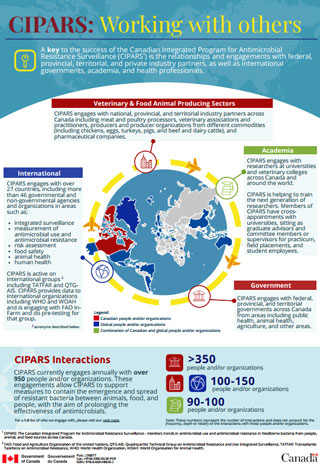CIPARS: Working with others
Download in PDF format
(710 KB, 1 page)
Organization: Public Health Agency of Canada
Published: 2023-08-30
Pub: 230077
Cat: HP40-339/2023E-PDF
ISBN: 978-0-660-48820-2
A key to the success of the Canadian Integrated Program for Antimicrobial Resistance Surveillance (CIPARSFootnote 1) is the relationships and engagements with federal, provincial, territorial and private industry partners, as well as international governments, academia, and health professionals.
CIPARS interactions
CIPARS currently engages annually with over 950 people and/or organizations. These engagements allow CIPARS to support measures to contain the emergence and spread of resistant bacteria between animals, food, and people, with the aim of prolonging the effectiveness of antimicrobials.
The number of people and/or organizations broken down by type of organizationsFootnote 2:
- Government agencies: more than 350 people and/or organizations
- Veterinary and food animal producing sectors and international agencies: 100 to 150 people and/or organizations
- Academia: 90 to 100 people and/or organizations
For a full list of who we engage with, please visit our web page.
Veterinary and food animal producing sectors
CIPARS engages with national, provincial, and territorial industry partners across Canada including meat and poultry processors, veterinary associations and practitioners, producers and producer organizations from different commodities (including chickens, eggs, turkeys, pigs, and beef and dairy cattle), and pharmaceutical companies.
Academia
CIPARS engages with researchers at universities and veterinary colleges across Canada and around the world.
CIPARS is helping to train the next generation of researchers. Members of CIPARS have cross-appointments with universities, sitting as graduate advisors and committee members or supervisors for practicum, field placements, and student employees.
Government
CIPARS engages with federal, provincial, and territorial governments across Canada from areas including public health, animal health, agriculture, and other areas.
International
CIPARS engages with over 27 countries, including more than 46 governmental and non-governmental agencies and organizations in areas such as:
- integrated surveillance
- measurement of antimicrobial use and antimicrobial resistance
- risk assessment
- food safety
- animal health
- human health
CIPARS is active on international groups including Transatlantic Taskforce on Antimicrobial Resistance (TATFAR) and Quadripartite Technical Group on Antimicrobial Resistance and Use Integrated Surveillance (QTG-AIS). CIPARS provides data to international organizations including the World Health Organization (WHO) and the World Organisation for Animal Health (WOAH) and is engaging with the Food and Agriculture Organization of the United Nations (FAO) In-Farm and does pre-testing for that group.
Footnotes
- Footnote 1
-
CIPARS: The Canadian Integrated Program for Antimicrobial Resistance Surveillance - monitors trends in antimicrobial use and antimicrobial resistance in foodborne bacteria from people, animal, and food sources across Canada.
- Footnote 2
-
These numbers represent the number of interactions and does not account for the frequency, depth or history of the interactions with those people and/or organizations.
